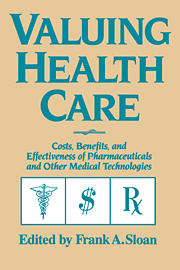 Valuing Health Care
Valuing Health Care Book contents
- Frontmatter
- Contents
- List of Tables
- List of Figures
- List of Boxes
- Acknowledgments
- 1 Introduction
- 2 Evidence of effectiveness: evaluating its quality
- 3 Utility assessment for estimating quality-adjusted life years
- 4 Measuring costs
- 5 From cost–effectiveness ratios to resource allocation: where to draw the line?
- 6 Valuing health care benefits in money terms
- 7 Discounting health effects for medical decisions
- 8 Statistical issues in cost–effectiveness analyses
- 9 Decision trees and Markov models in cost–effectiveness research
- 10 The use of cost–effectiveness/cost–benefit analysis in actual decision making: current status and prospects
- Notes
- References
- Index
6 - Valuing health care benefits in money terms
Published online by Cambridge University Press: 07 December 2009
- Frontmatter
- Contents
- List of Tables
- List of Figures
- List of Boxes
- Acknowledgments
- 1 Introduction
- 2 Evidence of effectiveness: evaluating its quality
- 3 Utility assessment for estimating quality-adjusted life years
- 4 Measuring costs
- 5 From cost–effectiveness ratios to resource allocation: where to draw the line?
- 6 Valuing health care benefits in money terms
- 7 Discounting health effects for medical decisions
- 8 Statistical issues in cost–effectiveness analyses
- 9 Decision trees and Markov models in cost–effectiveness research
- 10 The use of cost–effectiveness/cost–benefit analysis in actual decision making: current status and prospects
- Notes
- References
- Index
Summary
This chapter discusses the measurement of benefits from health interventions in monetary terms and specifically why and how monetary values are attached to health benefits. This discussion explores in detail the relationship between two commonly used methods of measuring the desirability of new programs or new products, especially new drugs. One method, cost–benefit analysis, is the economic approach that measures both resource costs and health benefits in monetary terms. The other method is cost–effectiveness analysis, which measures health outcomes in nonmonetary terms either as physical or as utility measures, while maintaining monetary measures for explicit (budgetary) resource costs and, frequently, for implicit costs. The difference between the two methods consists entirely in the way good outcomes are measured. The processes, advantages, and disadvantages of measurement in monetary terms are thus illustrated in comparison with the alternative.
Two primary questions about cost–benefit and cost–effectiveness analysis are addressed in this chapter. The first question is what differences are there between these two methods? A method will be called different from some other method if it will, in at least some possible state of the world, lead to a different conclusion about which program is preferable. The second question is, if there are differences, which method should a decision maker use? Such a normative conclusion obviously depends on the decision maker's objectives, so this question will be addressed in an indirect way by showing which objectives are consistent with the choices made under each method.
- Type
- Chapter
- Information
- Valuing Health CareCosts, Benefits, and Effectiveness of Pharmaceuticals and Other Medical Technologies, pp. 99 - 124Publisher: Cambridge University PressPrint publication year: 1995
- 37
- Cited by
